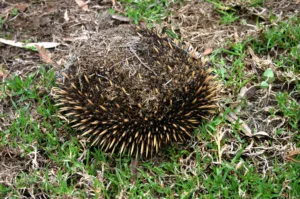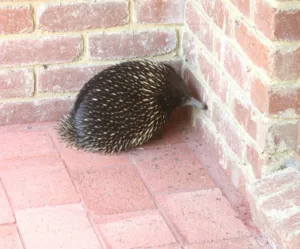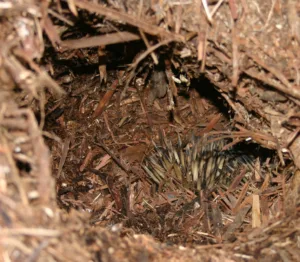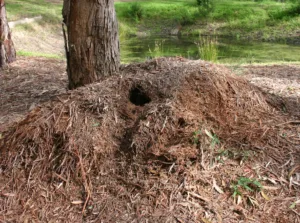The logo which you see on our website, merchandise and track markers was created by Gippsland teacher Dan Towb and was the winning entry in a public competition to create a logo for the Grand Strzelecki Track in 2010. As you can imagine, lyrebirds featured heavily amongst the competition entries and rightfully so, being such an abundant and instantly recognizable part of our mountain forests, but the lyrebird has been so often used on logos for so many things that we felt the echidna deserved a turn. Echidnas are such sturdy little creatures and ramble far and wide on their daily quest, which makes them an appropriate choice. We also really like Dan’s design! On top of that, while deliberating over the various entries at the Tarra-Bulga Guest house one afternoon, a young echidna waddled up to the full-length window on the front veranda and pressed his beak against it, peering in at us as if to say, “pick me, pick me!” How could we refuse?
The article below reveals some fascinating insights into the life of the echidna most people probably don’t know. It first came to my attention last year in the Binginwarri Landcare Group Newsletter, ‘The Bingi Babbler’. Its local author, John McClumpha, is a knowledgeable and passionate field naturalist who strives to further our appreciation of our native fauna, so it receives the consideration it deserves. He was only too happy to share this with us. John, we hope this helps the cause!
ECHIDNAS by John McClumpha
I discovered the kindling stack in my wood shed spread across the floor one July evening. As I generally keep the wood shed door closed it was a mystery as to what had happened here. On entering the shed the next day I found the reason. An echidna was crossing the floor from the wood pile. I left the door open and it was gone that evening. Echidnas turn up in all sorts of places. I have a pile of bark mulch in which an echidna has burrowed for 2 consecutive winters. I had several bags of stable manure which I had mulched and stored in an open shed area. On spreading one bag onto the vegetable garden I discovered a lump – an echidna!
Ex the stable manure venture with spines raised!
Echidnas often roam the area adjacent to my house and in the adjacent bush however they are not so easy to spot in the bush as they will partially burrow into the ground and form themselves into a ball on hearing someone approaching and remain very still which can make them difficult to detect. However, it is easy to spot where they have been as they leave shallow diggings where they search for food. These diggings are 10 to 20 cm deep by 20 to 30 cm wide, generally with a distinctive indent at the bottom where their beak has pushed into the ground.
Their defence mechanism is the cream coloured spines on their back which generally lie flat on their body but are raised when they sense danger. These spines are actually modified hair made of material similar to our finger nails. They are quite sharp and deter the majority of would be predators. The male also has a spur on each hind foot and although the spur has a venom gland this gland is not functional. It possibly was when they roamed with the dinosaurs.
The echidna is an egg laying mammal. They and the platypus are the only egg laying mammals in the world. There are 2 species of echidna. A long-beaked species which is confined to the highlands of New Guinea and the short-beaked species which lives in Australia and New Guinea. They are relatively common right across Australia but as they do not like the heat they are often only mobile at night during the warmer periods and in northern Australia.
This is my corner of the verandah!!
The echidna is normally a solitary animal however during the breeding season, June to September, it is possible to see several males following a female, an “Echidna Train”, which may last up to 3 weeks before one male triumphs and mates. At the beginning of the breeding season the female develops a small pouch and 22 days after mating a single egg is produced into the pouch. 10 days later the young echidna, using a temporary tooth on its muzzle, breaks the egg shell to start its life in the world. It remains in the mothers pouch for 6 to 8 weeks at which time its spines start to develop. The young feed solely on its mother’s milk until it leaves the nursery burrow. The female milk glands are like pads within the pouch which the young lick or suckle on. They do not have nipples as do other mammals. Young echidnas stay in the nursery burrow for up to 12 months before venturing into the outside world. Whilst in the burrow they are fed by the mother who returns every 5 to 10 days.
The echidna is equipped with very strong, long claws to allow it dig in soil, rotting logs and termite mounds. Its general diet is ants and termites but they also eat grubs, larvae and worms. It is equipped with a long, 15 cm, thin tongue which is covered with sticky mucous. By flicking the tongue amongst its prey’s nest the prey stick to the tongue and is retrieved into the echidna’s mouth where it is crushed between the tongue and the bottom of the mouth before being swallowed. Large grubs are squashed with their beak and then licked up. Due to the manner in which they feed echidnas consume a large amount of dirt which makes their droppings easily definable.
Some interesting facts:
- A young echidna is called a puggle.
- Puggles are about 1.5 cm long when the leave the egg.
- Echidnas are very good swimmers and is often used as an escape mechanism from a predator.
- Echidnas start breeding at about 6 years of age and only every 3 to 7 years after that.
- An “Echidna Train” of up to 11 echidnas has been recorded.
- Echidnas grow up to 50 cm long.
- Echidnas are territorial and live within an area of 40 to 70 hectares.
- The echidna lifespan is 10 to 15 years in the wild. However they have been recorded as living to 45 years.
- Echidnas do not have any teeth.
- Echidnas are able to fast for several weeks in areas where food is scarce.
- Echidnas do not have external ears, only 2 small slits on each side of their head.
- Echidnas have an excellent sense of smell which assists then when foraging for food.
- Echidnas are found in forests, grasslands, shrublands, rocky outcrops and agricultural land.
- Echidnas have an extra long claw on each of their hind feet which is used for grooming.
- Fossilised remains indicate that echidnas were around at least 100 million years ago.
Nesting in the bark mulch.
As the above demonstrates the echidna is a very unique animal and it has few natural predators. It is known that goannas will eat them and snakes will invade burrows and eat the young if their spines are not very developed. There are some introduced predators which we need to control; these are domestic and feral cats, dogs and foxes. We also need to ensure we do not destroy their food sources such as termite mounds, ants nests, rotting logs, bush litter or damage their burrows. They certainly do not have any road sense so if you see one on the road move it into the bush or adjacent paddock. Despite their sharp spines they can be easily lifted using heavy duty gloves or a cloth such as a towel or jumper. Be careful not to drop them as their beak can be easily broken.
(John McClumpha, Hedley Range Road, Binginwarri, November 2011)




